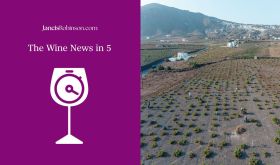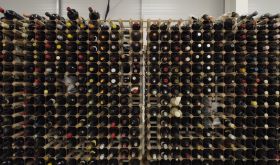Somehow it is already the end of April, which means that – drumroll please – we have launched our 2025 wine writing competition (WWC25)! It also means that port houses are beginning to declare their 2023 vintage and Bordeaux is beginning its 2024 en primeur campaign. On a more depressing note, the Pesticide Action Network Europe (PAN Europe) released a report this week on a significant increase of trifluoroacetic acid (TFA) – a forever chemical – in European wine over the last three decades. But starting on good news …
Our wine writing competition
The theme this year is, ‘An ode to a grape variety’ and we are accepting essays, fiction and non-fiction stories, and poems. You can find all the details on our site. Submissions are due no later than 23 June.
As an aside, this competition is very near and dear to my heart. In 2019, I was shortlisted, the same year I wrote my first harvest journal for the site. I feel I owe a lot to this competition! And I now have the great privilege of helping to judge alongside the rest of our full-time team as well as Julian Leidy, who manages everything competition-related, Hermione Ireland, from The Académie du Vin Library, and a guest judge yet to be announced.
2023 port declarations
As you are likely aware, vintage port is not produced every year. It is produced only in the best vintages. But not every port producer agrees on what constitutes the ‘best’ vintage. So what happens is that, about 14–16 months following a vintage, port producers taste their wines and decide whether they think the quality was uniformly good enough across all of their properties to make a vintage port. If they believe it was, they submit their wine to the IVDP (Instituto dos Vinhos do Douro e do Porto) to see if it meets the Institute’s standard. If approved, they declare that vintage to the public. If they don’t wish to declare a vintage, they look at the quality of each of their single properties (which would otherwise have gone into the vintage blend) and they may choose to submit single-quinta vintage ports to the IVDP from their best-performing properties.
Roughly speaking, for ruby ports the quality hierarchy from top to bottom goes: vintage port, then single-quinta vintage port, then late-bottled vintage (LBV) or crusted, then ruby reserve, then entry-level ruby.
Thus far for 2023, no house has declared a full-fledged vintage. Churchill has declared Quinta da Gricha, Ramos Pinto has declared Quinta do Bom Retiro, and Taylor’s has declared their multi-property blend from the subregion of Feitoria that they launched last year – called Sentinels. Symington’s brands have declared single quintas, with Cockburn’s declaring Quinta dos Canais, Dow’s declaring Quinta do Bomfim and Quinta da Senhora da Ribeira, Graham’s declaring Quinta dos Malvedos, Warre’s declaring Quinta da Cavadinha, and Quinta do Vesúvio declaring their standard bottling. If you’re curious, The Port Forum does an excellent job of tracking what has been announced.
After announcements have finished in September, The Port Wine Brotherhood and the IVDP will compile their data and decide whether enough producers declared that the vintage can be considered a ‘classic vintage year’.
2024 bordeaux en primeur
Last week, Bordeaux hosted 2024 en primeur tastings. What that means is that members of the trade and media were in Bordeaux tasting barrel-samples of the yet-to-be-released 2024 vintage from the most prestigious Bordeaux estates. While these wines won’t be bottled for another year, a proportion will be offered for sale in the coming weeks. Importers and distributors will pre-pay for the wines that they want in order to secure them at potentially lower prices than when the bottled wines are released – they will then offer them to their retail buyers. Historically, this arrangement was meant to secure early revenue for producers and allow consumers to get a better deal on sought-after wines … but in recent years, prices have climbed so high that demand for en primeur wines has faltered and wines on the market often sell for less than their en primeur prices – causing experts to call on producers to slash prices for this 2024 vintage.
If you’re curious about getting your hands on sought-after bordeaux and are considering buying en primeur in the current market, it is a good idea to have the maximum amount of information possible.
Starting on Monday, James Lawther MW will be releasing his tasting notes and scores on the 2024 vintage. His overview of this challenging vintage was published yesterday. Meanwhile, on our Members’ forum, Nick Martin, who founded Wine Owners, is updating our members on en primeur release prices and how both prices and scores stack up against previous comparable vintages. Thus far, only a handful of châteaux including Batailley, Pontet-Canet, Branaire-Ducru, Latour à Pomerol and La Fleur-Pétrus have released pricing – all have reduced their prices relative to last year but, thus far, none has dropped prices significantly enough to make the wines seem like great value.
The Pesticide Action Network Europe’s latest report
On 23 April PAN Europe released a report on, ‘The Rapid Rise of TFA Contamination Across the EU’. TFA, or trifluoroacetic acid, is a so-called ‘forever chemical’ that cannot be broken down by natural processes and accumulates in water, soil and plants and is suspected to affect reproductive health. TFA has been proven to be a breakdown product of certain pesticides. PAN Europe’s latest report specifically looks at contamination in wine, with testing carried out across 10 European wine-producing countries. In samples of wine made prior to 1988 there is no detectable TFA. From 2021 to 2024 wines showed average levels of 122 µg/l, with some peaks of over 300 µg/l.
There have been a lot of headlines around this news, but it’s important to remember that this study was looking at wine rather than, say, olives, purely, and I quote, ‘for a specific reason: for no other agricultural product are the harvests from past decades so readily available and well preserved.’ It’s likely that TFA has increased in nearly every agricultural product over the last few decades; so however you assess the evidence about TFA and human health, it’s not a reason to demonise wine.
That’s all for this episode of the wine news. If you enjoy this newscast and would like to see it continue, please subscribe to JancisRobinson.com. And if you have breaking news in your area, please email news@jancisrobinson.com.
This is a transcript of our weekly five-minute news broadcast, which you can watch below. You can also listen to it on The Wine News in 5 Podcast. If you enjoy this content and would like to see more like it, please subscribe to our site and our weekly newsletter.














